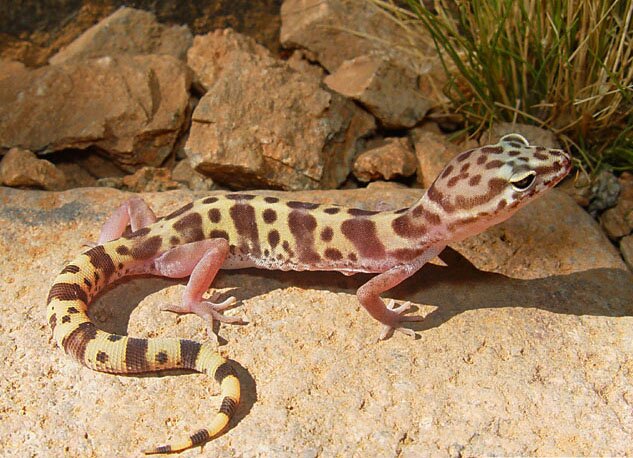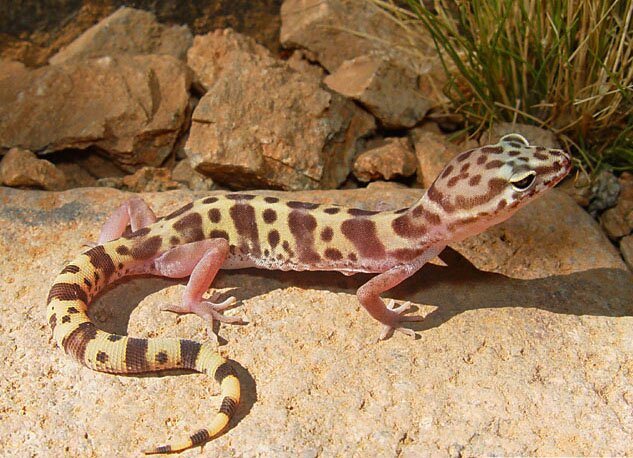I’d like to know more about breeding banded gecko lizards.
Q. I recently obtained a pair of banded geckos (Coleonyx variegatus). I had them in a 25-gallon tank until I found out that the female was close to laying a clutch of eggs. I put this female banded gecko in a smaller cage until it laid its eggs. I’d like to know more about the breeding behavior of these delicate geckos.
Bennett Hubbard
Morongo Valley, Calif.
A. The banded gecko is one of the eyelid geckos, closely related to the leopard gecko (Eublepharis macularius). It breeds in much the same way as the leopard. Though these little geckos (even large females are seldom more than 6 inches) look delicate, with very thin, almost translucent skin, they are hardier than they appear. They do quite well in the terrarium. Because most banded geckos are wild-caught and sold at low prices, few hobbyists intentionally breed them. They really aren’t that difficult, as you probably already know. Expect any banded gecko much over 2 inches long (excluding the tail) to be sexually mature. Sexing is easy; even young males have eight to 10 pores in a line in front of the cloaca. These are absent in females. Mature males also have obvious cloacal bones with pointed tips projecting out and forward from under the base of the tail; females have flaps of skin instead. Females tend to be larger overall, perhaps by an inch.

Photo Credit: AzWildcard/Wikimedia
Banded geckos breed in the spring after a winter of reduced activity.
As with many North American herps, banded geckos breed in the spring after a winter of reduced activity. They are often more productive if cooled for two to three months during the previous winter. Reduce feeding starting around Thanksgiving, and gradually drop the temperature to about 65 degrees Fahrenheit and hold it there for at least two months. At the same time, reduce day length to less than eight hours a day.
Water should always be present, and you must check the banded geckos at least every week for signs of dehydration or fungi and bacteria. Some banded geckos feed a little during the cooling period, but most survive just fine on fats and water stored in their tails and abdomens.
By mid-February or so, start warming them up and increase the day length, then allow them to feed freely. The cooling period allows the testes of the male banded gecko to enlarge and produce viable sperm. Place a single male with three or four females in March, and expect many eggs starting within six weeks to two months.
Mating behavior is simple. The male banded gecko finds the female probably by a combination of sight and smell. He approaches her with his toothpick legs held stiff and straight. If the female is ready to mate, she stands still and raises her tail slightly, while the male moves up to her and bites her on the nape to help move her body into position for mating. Sperm transfer may be finished in just a few seconds. Because mating takes place at night, it seldom is noticed.
A gravid female banded gecko develops two large, white eggs in her abdominal cavity that can be seen and felt through the skin. Many banded geckos lay two clutches a year, and a female can store sperm for several months. As soon as you can detect the eggs, provide a nesting box, generally a plastic sandwich box with a lid and a hole cut into the side or top. Fill the box with moist (not wet) vermiculite and/or sphagnum moss. Check the box each morning, and look closely at each female to see when the eggs are laid.
Remove the eggs to a simple incubator or at least a separate container where they can be maintained at 80 to 85 degrees and at least 80-percent humidity. Complicated incubators are not necessary; you can keep the banded gecko eggs on a moist vermiculite layer in a small plastic container. Place the container inside a larger tank sitting on an undertank heater adjusted to maintain the proper temperature. Add water to the vermiculite from the sides of the container; don’t directly wet the eggs, which should be half-buried in the substrate.
Unlike leopard geckos, sex in banded geckos is determined by genetics, not incubation temperatures. The typical incubation period at the above temperatures is roughly six weeks. The young are 2-inch-long jewels that need tiny insects and spiders for their first few months. They usually take their first meal when theyre 5 to 8 days old, after their first shed. They may be sexually mature at 8 months of age. These geckos live much longer than you might guess, with ages of 6 to 8 years common, and a record of over 15 years.
One last thought: Because you live in California and this species is native to your state, you probably will find that you must secure a hobby permit before you can legally keep and breed banded geckos, regardless of the source of your animals. Please try to abide by all local laws, and don’t try to take any shortcuts.


